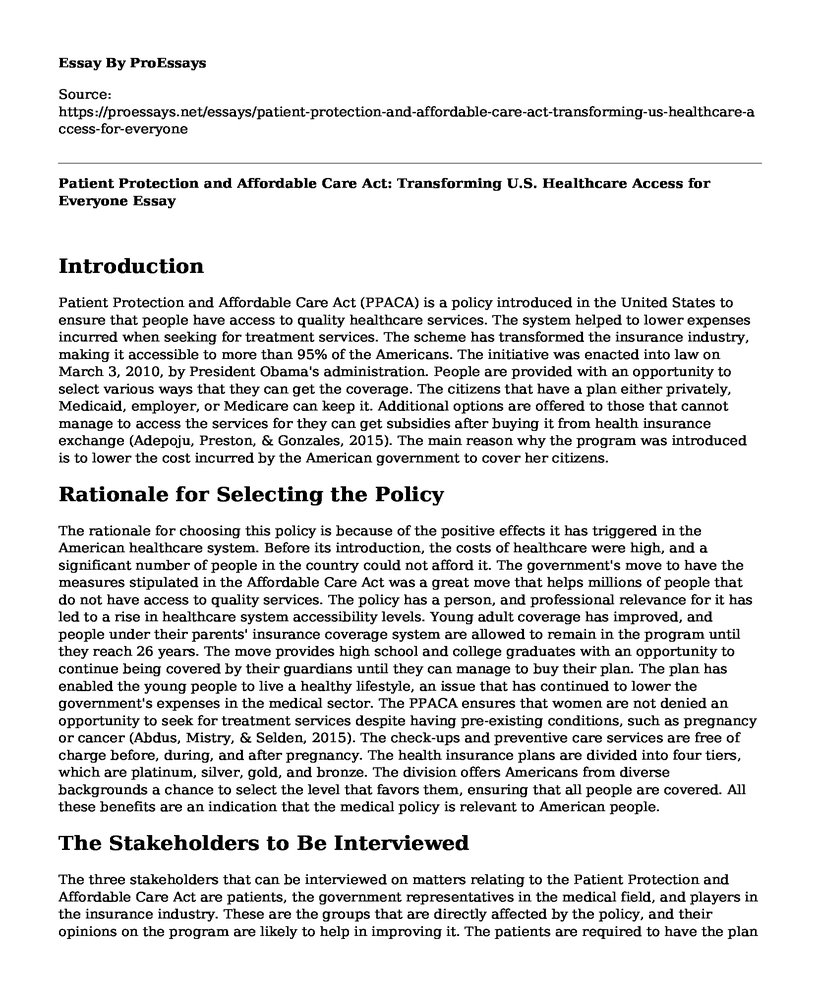Introduction
Patient Protection and Affordable Care Act (PPACA) is a policy introduced in the United States to ensure that people have access to quality healthcare services. The system helped to lower expenses incurred when seeking for treatment services. The scheme has transformed the insurance industry, making it accessible to more than 95% of the Americans. The initiative was enacted into law on March 3, 2010, by President Obama's administration. People are provided with an opportunity to select various ways that they can get the coverage. The citizens that have a plan either privately, Medicaid, employer, or Medicare can keep it. Additional options are offered to those that cannot manage to access the services for they can get subsidies after buying it from health insurance exchange (Adepoju, Preston, & Gonzales, 2015). The main reason why the program was introduced is to lower the cost incurred by the American government to cover her citizens.
Rationale for Selecting the Policy
The rationale for choosing this policy is because of the positive effects it has triggered in the American healthcare system. Before its introduction, the costs of healthcare were high, and a significant number of people in the country could not afford it. The government's move to have the measures stipulated in the Affordable Care Act was a great move that helps millions of people that do not have access to quality services. The policy has a person, and professional relevance for it has led to a rise in healthcare system accessibility levels. Young adult coverage has improved, and people under their parents' insurance coverage system are allowed to remain in the program until they reach 26 years. The move provides high school and college graduates with an opportunity to continue being covered by their guardians until they can manage to buy their plan. The plan has enabled the young people to live a healthy lifestyle, an issue that has continued to lower the government's expenses in the medical sector. The PPACA ensures that women are not denied an opportunity to seek for treatment services despite having pre-existing conditions, such as pregnancy or cancer (Abdus, Mistry, & Selden, 2015). The check-ups and preventive care services are free of charge before, during, and after pregnancy. The health insurance plans are divided into four tiers, which are platinum, silver, gold, and bronze. The division offers Americans from diverse backgrounds a chance to select the level that favors them, ensuring that all people are covered. All these benefits are an indication that the medical policy is relevant to American people.
The Stakeholders to Be Interviewed
The three stakeholders that can be interviewed on matters relating to the Patient Protection and Affordable Care Act are patients, the government representatives in the medical field, and players in the insurance industry. These are the groups that are directly affected by the policy, and their opinions on the program are likely to help in improving it. The patients are required to have the plan to ensure that they have access to quality services. Failure to register for the system attracts penalties, and it can also lead to an inability to get treatment. The government funds the healthcare system, and one of the reasons why it introduced it is to lower the amounts set aside for the sector. Therefore, the existence of the system ensures that the costs incurred by the American government in the medical industry have reduced (Chuang et al., 2015). PPACA calls for people to have insurance coverage, and this is an indication that insurance companies are affected by the introduction of the policy. There is a probability that claims have increased affecting their operations.
References
Abdus, S., Mistry, K. B., & Selden, T. M. (2015). Racial and ethnic disparities in services and the Patient Protection and Affordable Care Act. American journal of public health, 105(S5), S668-S675. Retrieved from https://ajph.aphapublications.org/doi/pdfplus/10.2105/AJPH.2015.302892
Adepoju, O. E., Preston, M. A., & Gonzales, G. (2015). Health care disparities in the post-Affordable Care Act era. American Journal of Public Health, 105(S5), S665-S667. Retrieved from https://ajph.aphapublications.org/doi/pdfplus/10.2105/AJPH.2015.302611
Chuang, C. H., Mitchell, J. L., Velott, D. L., Legro, R. S., Lehman, E. B., Confer, L., & Weisman, C. S. (2015). Women's awareness of their contraceptive benefits under the Patient Protection and Affordable Care Act. American journal of public health, 105(S5), S713-S715. Retrieved from https://ajph.aphapublications.org/doi/pdfplus/10.2105/AJPH.2015.302829
Cite this page
Patient Protection and Affordable Care Act: Transforming U.S. Healthcare Access for Everyone. (2023, Feb 12). Retrieved from https://proessays.net/essays/patient-protection-and-affordable-care-act-transforming-us-healthcare-access-for-everyone
If you are the original author of this essay and no longer wish to have it published on the ProEssays website, please click below to request its removal:
- Contemporary Issues Criminal Justice System Essay
- Globalization and Illicit Activities Essay Example
- Essay Sample on Marijuana Legalization in the US
- Current Events Which Are Happening in Line With the 8th Amendment in the USA
- Essay Sample on Criminal Defense
- Gun Control Among the United America Citizens - Essay Sample
- Essay on Crime and Poverty: Examining the Link Between Geography and Incarceration







